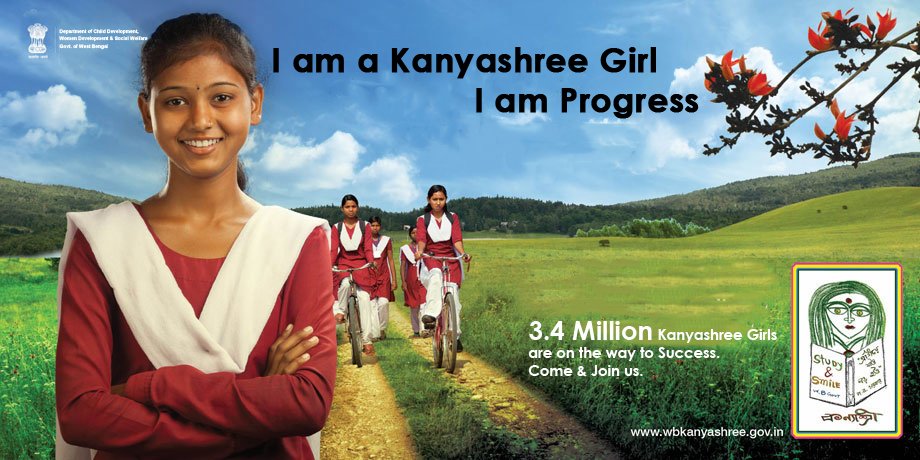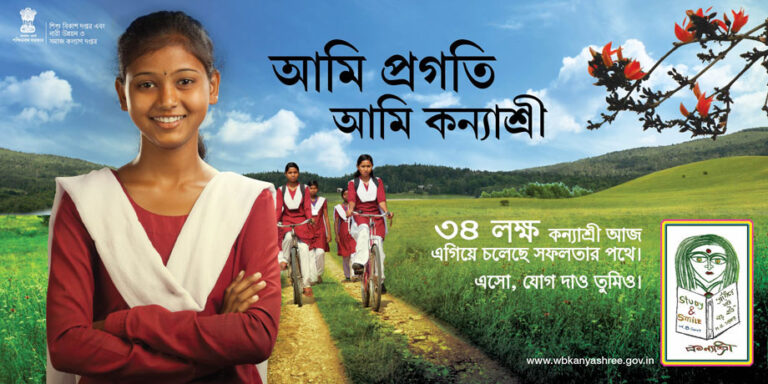The Kanyashree Prakalpa Scheme is a flagship initiative by the Government of West Bengal aimed at improving the status and well-being of girls, particularly those from socio-economically disadvantaged backgrounds. Check Kanyashree Prakalpa Scheme Eligibility, Application Process, Benefits & Other Latest Updates.
Table of Contents
Kanyashree Prakalpa Scheme 2025 – Overview

| Feature / Detail | Description |
|---|---|
| Scheme Name | Kanyashree Prakalpa |
| Launched By | Government of West Bengal |
| Objective | Encourage girls to stay in school and delay marriage till at least 18 |
| Type of Scheme | Conditional Cash Transfer (CCT) |
| Beneficiaries | Unmarried girls aged 13 to 18 (K1) and 18+ (K2) from low-income families |
| Annual Scholarship (K1) | ₹₹750 per year (upgraded to ₹1,000 in later phases in some districts)(aged 13–18) |
| One-Time Grant (K2) | ₹25,000 on turning 18, if unmarried and in education or training |
| Higher Education Support (K3) | ₹2,500 per month for postgraduate studies (available under extended phase) |
| Eligibility – Income | Family income below ₹1.2 lakh per year (waived for special categories) |
| Special Categories | Disabled girls, orphans, girls in JJ Homes – income limit not applicable |
| Education Requirement | Must be in Class VIII or above (K1) or in any academic/vocational training |
| Bank Account Requirement | Must have a bank account in the girl’s name |
| Mode of Disbursement | Direct Benefit Transfer (DBT) to beneficiary’s bank account |
| Application Mode | Through schools/institutions or online portal |
| Documents Required | Age proof, residence proof, income certificate, education proof, etc. |
| Official Website | www.wbkanyashree.gov.in |
| Implemented By | Department of Women & Child Development and Social Welfare, West Bengal |
| Awards & Recognition | United Nations Public Service Award – 2017 |
| Scheme Impact | Over 7 million beneficiaries, reduced child marriage, improved education |
Kanyashree Prakalpa Eligibility Criteria
To be eligible for the Kanyashree Prakalpa Scheme, applicants must fulfill the following conditions based on the type of benefit:
- The applicant must be a permanent resident of West Bengal
- The applicant should be unmarried at the time of applying
- She must be enrolled in an academic institution (school, college, or vocational training institute).
- Her family’s annual income should be below ₹1.20 lakh
(Note: This income limit may be waived for specially-abled applicants or those residing in juvenile homes)
Other Eligibility Criteria for K1, K2, and K3
K1 Benefit – Annual Scholarship (₹750)
This benefit supports younger adolescent girls who are actively attending school:
- Age Group: 13 to 18 years
- Education Level: Class 8 to Class 12 (recognized institutions only)
- Academic Requirement: Consistent attendance and academic progression
K2 Benefit – One-Time Grant (₹25,000)
This grant is meant to support girls transitioning into adulthood while continuing their education:
- Age Bracket: 18 to 19 years
- Must be: Unmarried and Pursuing formal education or vocational training
K3 Benefit – Kanyashree Plus (Higher Education Support)
Aimed at ambitious young women pursuing careers or higher studies, this component provides additional support:
- Target Audience: Girls who’ve graduated from K2 and are seeking higher academic degrees
- Course Type: Undergraduate, Postgraduate, or Professional courses
- Commitment to continued education is essential
How to Apply for Kanyashree Prakalpa Scheme
1️⃣ Get the Application Form
- Available at schools, colleges, Block offices, or online via the official portal.
2️⃣ Fill in the Form
- Complete with personal, educational, and family details.
3️⃣ Attach Required Documents
- Age Proof, Income Proof, Residence Proof, etc.
4️⃣ Submit at School/Institution
- The institution will verify and forward it to the Higher Authority.
5️⃣ Verification and Approval
- The application is verified at Block/Municipal level.
6️⃣ Disbursement
- Funds are directly transferred to the beneficiary’s bank account via Direct Benefit Transfer (DBT).
Official Website of Kanyashree Prakalpa Scheme – Click Here
Documents Required for Kanyashree Prakalpa 2025 Application
To ensure a smooth application process under the K1, K2, or K3 categories of the Kanyashree Scheme, applicants must submit the following documents:
| 📄 Document Name | 📌 Purpose / Notes |
|---|---|
| ✅ Aadhaar Card | Proof of identity and residence |
| ✅ Birth Certificate | To verify age eligibility for K1 or K2 benefits |
| ✅ Institutional Certificate | Proof of enrollment in school/college/vocational center |
| ✅ Income Certificate | Confirms the family’s income is below ₹1.20 lakh per annum |
| ✅ Unmarried Declaration | Required to certify that the applicant is unmarried at the time of applying |
| ✅ Bank Passbook (Photocopy) | For Direct Benefit Transfer (DBT) of the scholarship/grant |
| ✅ Passport-size Photograph | For identification on official forms and portal records |
| ✅ Disability Certificate (if applicable) | To claim income relaxation or special benefits |
| ✅ Juvenile Home Certificate (if applicable) | Required for applicants under state care |
Click Here for More Government Schemes
Main Goals of Kanyashree Prakalpa Scheme
Incentivizing Education
- Motivates girls to stay in school longer.
- Supports completion of secondary and higher secondary education.
- Builds a foundation for employment and social mobility.
Discouraging Early Marriage
- Disincentivizes marriage before age 18, the legal minimum.
- Aims to reduce:
- Early pregnancies
- Maternal and child mortality risks
- Health issues including malnutrition
Beyond Monetary Support
- Focuses on financial inclusion.
- Benefits are paid directly into girls’ bank accounts.
- Empowers girls to decide how to use the funds themselves.
Behaviour Change Communication Strategy
- Enhances social power and self-esteem among girls.
- Includes:
- Awareness campaigns about the scheme.
- Adolescent-friendly events and competitions.
- Formation of Kanyashree Clubs.
- Promotion of strong women role models.
- Supports social and psychological empowerment.
